|
|
|
f68v. MS 408. Credit: Beinecke Rare Book and Manuscript Library, Yale University. |
f86v ROSETTES
|
|
|
f68v. MS 408. Credit: Beinecke Rare Book and Manuscript Library, Yale University. |
The “rosettes” folio is the most complex of all the images in the Voynich Manuscript. I suggest it shows the work and observatories of Tycho Brahe, the location of the island of Ven in detail, Uraniborg and Stjerneborg the laboratories of Tycho Brahe on Ven and the detailed location of SN 1572, but I can only give the most superficial interpretation of the rest of the rosettes at this stage as it is a work in progress. I suggest microscopes and telescopes may be illustrated here (as has been suggested by Richard Santa-Coloma in the botany sections of the manuscript – see below). Given the suggested subject matter of the observations and life of Tycho Brahe who worked and dies before either were in common use or even may not have been invented, but I am not suggesting that he used these instruments or wrote the manuscript but the author dated after this time may have put them in an allegorical manner as they sum up Tycho’s view towards the connection between heaven and earth. To Tycho alchemy was “Earthly Astronomy” and astronomy “Heavenly Chemistry”, the macrocosm and microcosm intertwined one reflecting the other, the addition of instruments reflecting this search into the macrocosm (as defined by astronomy) and the microcosm (as defined by medicine) sums up Tycho’s endeavours and in this context is not out of place.
Despiciendo suspicio - "By looking down I see upward" and Suspiciendo despicio - "By looking up I see downward."
on emblems by Tycho Brahae.
TOP RIGHT ROSETTE
I suggest the top right rosette is the first one in the sequence and shows the position of Ven in detail in relation to the coast of Denmark and Sweden. Below shows the orientation of the rosette based on the T/O map to the top right. The typical layout of a T-O map shown alongside with Asia to the east at the top of the T.
|
|
|
|
T-O map from Etymologies by Isidore Saint, Bishop of Seville. 12th century. Public domain image. Source: Wikimedia Commonsf |
68v, top right rosette. MS 408. Credit: Beinecke Rare Book and Manuscript Library, Yale University. |
If the rosette is rotated to give north at the top the similarities to the location of Ven become apparent. The T/O map is still slightly off suggesting the actual orientation on a map would be slightly anticlockwise, but in this slightly off orientation of the T/O map (as originally above), it fits in with the link to the rosette below which I suggest is purposely done and indicates the overall location of Ven in the Oresund (the Sound).
|
|
|
|
Denmark and Sweden. Public domain image. Source: Wikimedia Commons. Additional titles added by P.Han. |
f68v, top right rosette. MS 408. Credit: Beinecke Rare Book and Manuscript Library, Yale University. Overlay by P. Han showing suggested landmarks in the top right rosette. |
Some comparative details of the Voynich Manuscript images on the top right rosette and images of their suggested identities.
|
|
|
|
|
Kronoberg Castle in Elsinore, Denmark by Debora Weber-Wulff. Licence GFDL. Source: Wikimedia Commons. |
I suggest this represents Kronborg Slot (castle), the castle that guards the entrance to the Oresund (the Sound) in the north on the Danish side. The castle does not have the Guelph (swallow-tailed) or Ghibelline (rectangular) merlons shown in the Voynich image, but their inclusion may be to reinforce its identity as “a castle” rather than being an exact likeness. Below an aerial view shows walls around the castle and an historical image of the castle dated 1622.
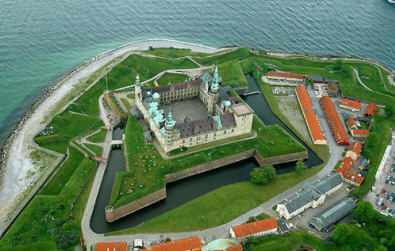 |
|
|
Elsinore, Denmark. Aerial Photo of Kronborg Castle by H.C. Steensen. Creative Commons licence: Attribution-ShareAlike license versions 3.0, 2.5, 2.0, and 1.0. Source: Wikimedia Commons. |
Kronborg Castle. View to Kronborg castle in 1622: Detail out of a painting "Allegory of the Sound" by Isaac Isaacsz in Kronborg Castle. Image by Wolfgang Sauber. Licence GFDL. Source:Wikimedia Commons. |
Below shows the image of the wall on the top right rosette. I suggest this depicts the sea/town walls from Kronborg Slot down to Copenhagen showing main towns or notable landmarks as towers, ending in the larger building depicting Copenhagen. The image next to it shows a view of Vartov in Copenhagen in 1658 which shows the type of city walls used in the area. In 1589 Tycho was given an old tower (Watermill tower) in the town wall of Copenhagen by as an observatory. This may signify the relevance of the wall being shown in the Voynich Manuscript rosette image because as early drawings of Elsinore show the area between Kronborg Slot and Copenhagen was pretty barren, a few towns but certainly no continuous development. This web page links to an early (date unknown) map of the area.
http://www.moranmicropublications.nl/images/KronborgCastleTheSound.jpg
|
|
|
|
|
f68v, top right rosette, close up of wall. MS 408. Credit: Beinecke Rare Book and Manuscript Library, Yale University. |
|
Old maps and drawings are often inaccurate and whether the wall in the rosette may depict the area along the sea from Kronborg to Copenhagen, just Elsinore or even just the walls around Kronborg Slot, my conclusion is that the rosette depicts the location of Ven in relation to Kronborg, Denmark and Sweden within the Oresund.
JOIN TO THE BOTTOM RIGHT ROSETTE
I suggest the link between the top right and right rosettes shows a long-range
view of Ven in the Oresund. The castle in the middle of the link between the
rosettes may indicate either of the two castles at the point where the gap
between land narrows, or may refer to Uraniborg which was the castle Tycho
constructed to live in on Ven as well as being an observatory and laboratory.
|
|
|
||
|
|
|
|
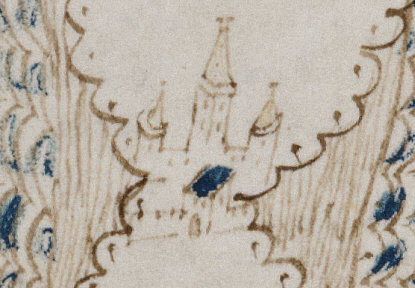 |
||
|
|
An historical map of the region is shown below and has been rotated to the same orientation.
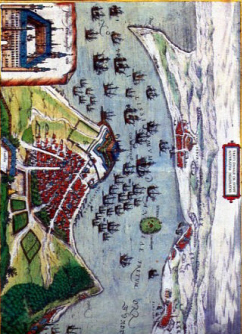 |
| Helsingor 1588. (Image has been rotated). Public domain image. Source: Wikimedia Commons |
BOTTOM RIGHT ROSETTE
I
suggest this shows the island of Ven in detail and specifically the location of
Uraniborg in relation to the cardinal directions. A detailed satellite image of
Uraniborg with a field to the top left and Stejernborg below can be seen on this
link below:
Rosette shown below with suggested labelling. Uraniborg and its gardens were designed to be precisely lined up to the compass and with the interpretation of the fiend to the north and Stjernborg to the south, the sun in the corner would indicate east and the rising sun. I suggest this works together with the sun in the top left of the folio and together provide the orientation of Uraniborg.
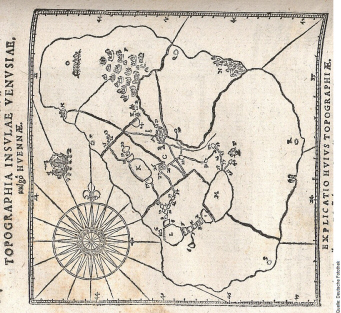 |
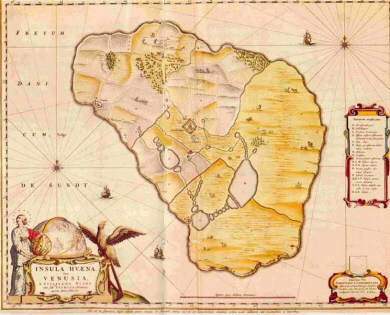 |
|
|
Map of Hven from copper etching of Blaeu Atlas 1663. North is to the top. Public Domain image. Source: Wikimedia Commons. |
|
|
| Tycho Brahe’s Uraniborg from Astronomiæ instauratæ mechanica, 1598. North is to the right, Stjerneborg to the left. Public Domain image. Source: Wikimedia Commons. |
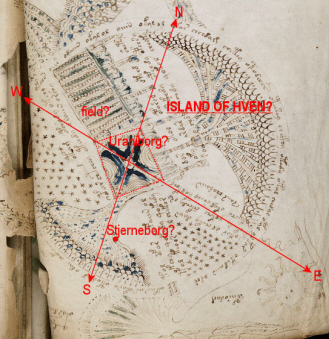 |
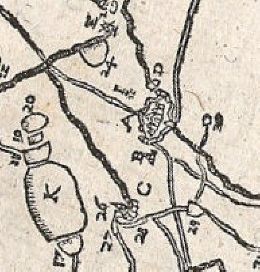 |
|
|
Cropped area of map shown above by Tycho Brahe. Astronomie & Architektur & Forschung & Karte. Brahe, Tycho, 1610. This file was provided to Wikimedia Commons by the Deutsche Fotothek of the Saxon State Library (SLUB) as part of a cooperation project. Licence: Creative Commons. Attribution-Share Alike 3.0 Germany. Source: Wikimedia Commons. |
The presence of sighting tubes indicates the most famous purpose of Uraniborg which was firstly as an observatory. If the manuscript was written later then the presence of telescopes which were not used by Tycho would never the less indicate the same purpose as observatory.
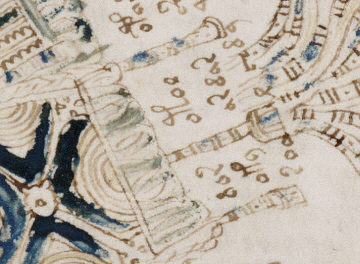 |
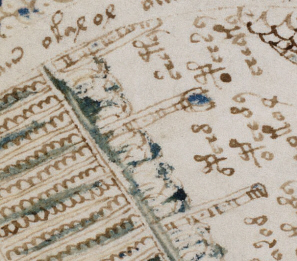 |
||
|
|
Below is shown an example of an early telescope.
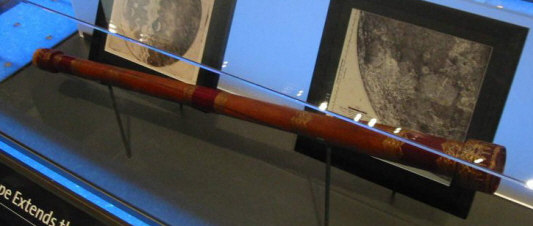 |
|
|
MIDDLE ROSETTE
I suggest this shows a detailed image of Uraniborg and its main functions. The cover of stars representing its function as an observatory and below the structures which look like apothecary jars, or microscopes relating to the other function of Uraniborg which had a basement built below for the study of alchemy. The presence of optics as related to the microscope has been suggested by Richard SantaColoma in his New Atlantis Voynich theory where he suggests the Voynich Manuscript contains optics. His theory can be read in detail here:
http://www.santa-coloma.net/voynich_drebbel/voynich.html
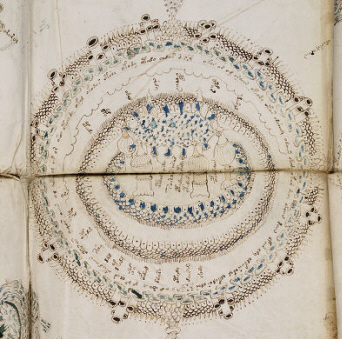 |
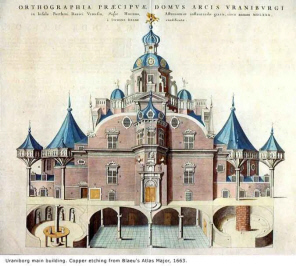 |
|
| f68v, middle rosette. MS 408. Credit: Beinecke Rare Book and Manuscript Library, Yale University. |
|
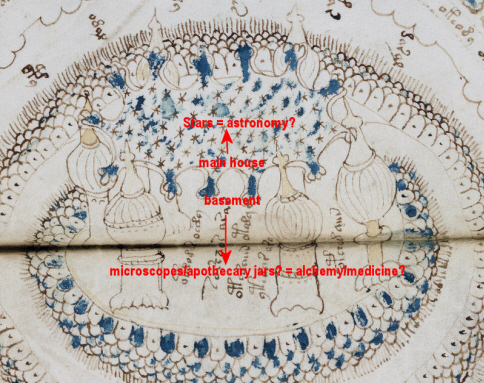 |
|
|
The function of Uraniborg as an alchemy laboratory was not secondary in importance to Tycho, chemical, medical and alchemical experiments were carried out. He and was not concerned with the usual pursuit of the transmutation of base metal into gold but in “iatrochemistry”, alchemy devoted to the development of medicines influenced by the work of figures such as Paracelsus (1493-1541). His gardens contained medicinal plants among the other types but apart from plants, chemicals such as sulphur and gold, or precious minerals such as pearl or sapphire were added to his medicines. His laboratory was the ideal facility to pursue the development of medicines, however examples of medicine he invented such as that for epilepsy which included “the head of a person who has been hanged or otherwise executed”, suggest medicine was not his greatest strength. There does not appear to be any reference to this type of alchemical imagery in the manuscript (except possibly the cube on f102r). Rather than referring to the type of plants specifically used by Tycho, the earlier and later botany sections of the manuscript may be a comparison between remedies and herbs contemporary to the time the Voynich Manuscript was written (or contemporary to Tycho) with ancient remedies and herbs (possibly of Chinese origin?).
The structures below the canopy of stars look very like those found in the botanical sections of the Voynich Manuscript. They may represent the various towers and turrets of Uraniborg - but with an added meaning. The fact that they only occur in the later part of the manuscript and in relation to partial plants and never with whole plants, and are not seen at all in the earlier parts of the manuscript and in conjunction with the study of plant based medicine at Uraniborg gives the possibility that they may be storage jars for finished medical recipes or microscopes. Whether they can reasonably be microscopes depends on the dating of the manuscript, which is far from solved. Obviously Tycho carried all his work out without the aid of the telescope or microscope and although I think the work of Tycho is shown in the manuscript, I do not believe he wrote it but it was written later by an author who remains unknown to this day. Thus if it was written in the late 17th century – early 18th century the inclusion of microscopes or telescopes (as suggested for the bottom right rosette) in a retrospective allegorical context is not beyond reason. Below are shown the main structures found under the canopy of stars and examples of similar structures from the botanical folios, although some appear to be shown without the “lid” there are still similarities in the structures. In the debate about the presence of microscopes and apothecary jars it is possible that both are shown.
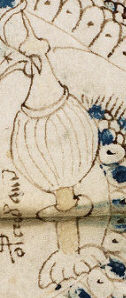 |
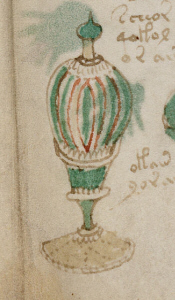 |
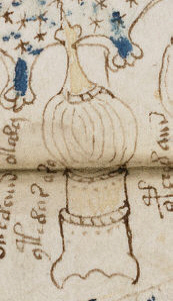 |
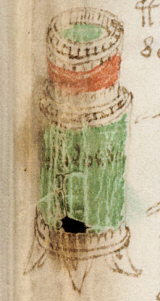 |
||||
|
|
|
|
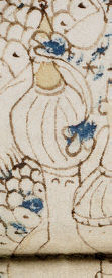 |
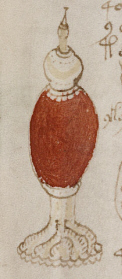 |
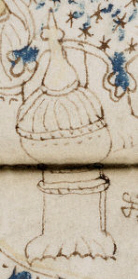 |
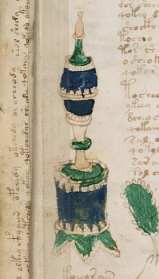 |
||||
|
|
|
|
TOP LEFT ROSETTE
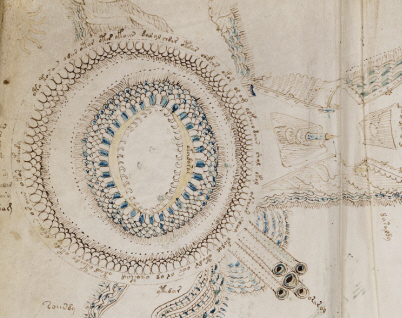 |
| f86v, top left rosette. MS 408. Credit: Beinecke Rare Book and Manuscript Library, Yale University. |
The tubes to the bottom left of the rosette may represent sighting tubes or telescopes and determine the feature as an observatory, or denote the five main instruments in the five main underground chambers.
|
|
| f86v, top left rosette. MS 408. Credit: Beinecke Rare Book and Manuscript Library, Yale University. Overlay by P. Han suggesting how counted elements in the image may relate to the partial eclipse as seen on 7th March 1598. |
Although at first glance this rosette displays what looks like crescent moons I suggest it relates to the details of the partial eclipse as seen on 7th March 1598. I suggest the numbers of various details of the image are significant; some details are difficult to count exactly as they may be faded or done roughly but have been recorded on the image above as accurately as possible. Tycho observed the eclipse near Hamburg having vacated the island of Ven the previous year, but it is thought he had someone take measurements of it on his behalf from Ven with what remained of the instruments. In November 1958, Tycho writes a letter to Goivani Magini detailing the eclipse as seen from Ven and in a letter sent by Tycho to Kepler in 1599 he gives further details and states they were taken from Ven with the remaining 4 instruments from beginning to end and agreed with his tables of calculations. Kepler reports this data in his book on Optics and in his Rudolphine Tables it is this particular eclipse that is used to illustrate the calculations of eclipses at specific localities, making this eclipse of particular significance and one whose details would be available to the public via the tables.
There appears to be an inner circle of crescent Moons but the number of crescents (37) does not correlate with lunar cycles, however this does correlate to the “eclipse season” or days when a solar eclipse may occur given the right conditions. The shape of the “crescent Moon” is also correct for the shape of the partial eclipse as seen from Ven. The writing label in the ellipse surrounding the “partial eclipse crescents” may refer to the orbit (orbis) of the Moon in determining the eclipse or to the details/opportune days of the eclipse (laborare). The next layer out has 58 oval shapes, of which 29 are blue.
These numbers have significance for the particular eclipse sighted; 58’ north or south is the maximum latitude of the Moon for an eclipse to occur. On 7th March 1598 as seen from Ven the latitude of the Moon (and therefore sun) was just over 28’. This could be the 29/58 as represented by the ovals?
The next two layers consist of many hair like marks with dots at intervals, the best count for these is 109 and 123. I suggest this represents the path of the Moon across the Sun in time from 10.09-12.03 as the time it was recorded as being visible.
The outer layer consists of rows of 95 ovals, this may be the degree of eclipse, e.g., 95% covered leaving only a thin crescent Moon shape.
The tubes to the bottom right of the rosette may represent sighting tubes or telescopes and suggest a celestial observation occurring, or denote the five original main instruments in the five main underground chambers on Ven.
I suggest the link between the top and the top left rosette shows Stejernborg, the second observatory that Tycho built on Ven to provide more space for the study of astronomy, situated to the south of Uraniborg. It was built partially underground on a hill near to Uraniborg to provide more stability for observational instruments and protection from the elements. The main feature is the fact that the image in the manuscript shows a tower which is underground but rises above ground also, along with other towers walls and buildings. It is obviously not an exact copy but seems to carry enough information to identify it while remaining “encoded” like much else in the manuscript. The fact that the vaulted roof of the underground study was turfed over to look like a hill, a metaphoric “Mount Parnassus, home of the Muses”, fits in very well with the imagery in the manuscript and is also a metaphor for poetry, literature, and learning - in this instance the study of astronomy.
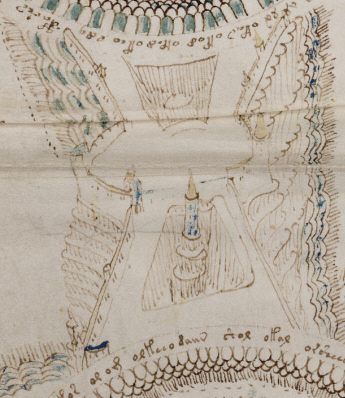 |
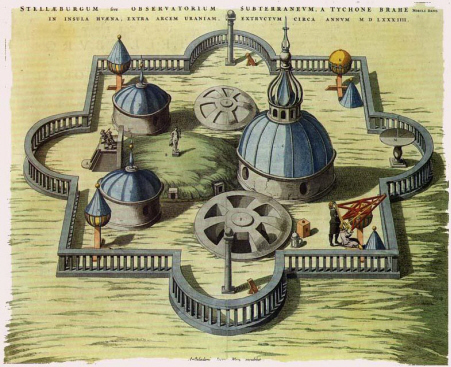 |
||
|
|
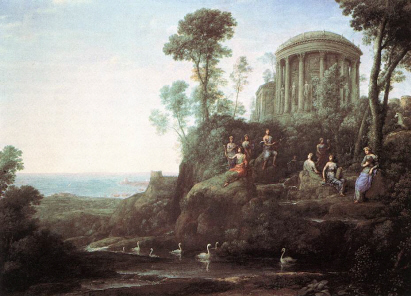 |
|
|
BOTTOM LEFT ROSETTE
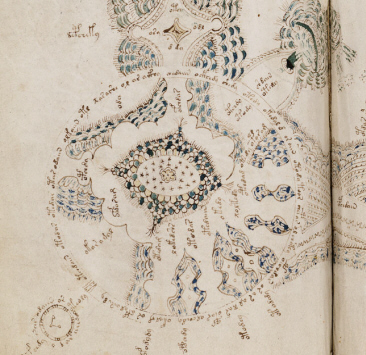 |
|
|
I suggest this rosette shows details of SN 1572 and its relation to the pole. Below I suggest the position of SN 1572 within Cassiopeia is shown in detail, showing the main part of the “W” of Cassiopeia.
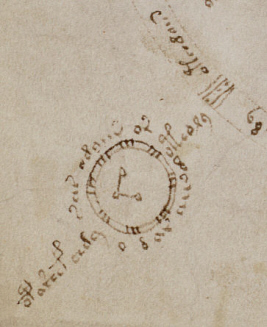 |
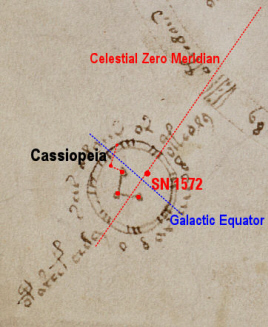 |
||
|
|
Below is a general star map showing the cardinal directions to compare with directions as they may be shown in the bottom left rosette.
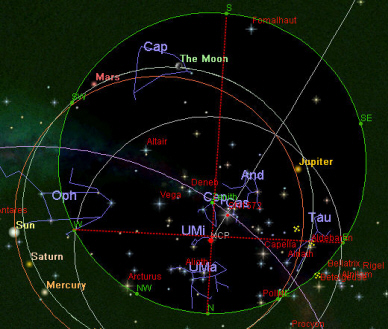 |
|
|
The rosette, the star map and bottom left rosette image line up well together, given one would not expect the accuracy of modern star maps in the manuscript. The “W” lines up in one direction and the nest like image opposite the “W”, suggesting the “W” may be an accurate location within Cassiopeia and the nest like image a descriptive picture of the birth of a new star.
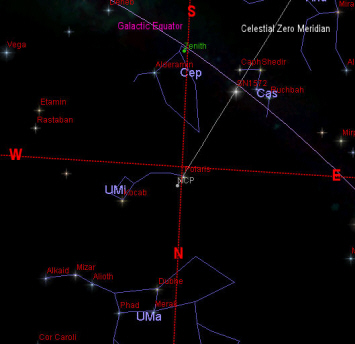 |
 |
|
| Possible orientation of bottom left rosette as shown on star map. Credit: Redshift6. Overlay by P. Han |
|
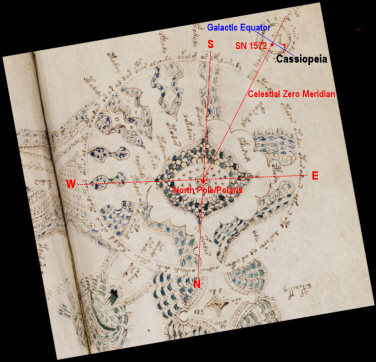 |
| f86v, bottom left rosette. MS 408. Credit: Beinecke Rare Book and Manuscript Library, Yale University. Overlay by P. Han. |
RIGHT ROSETTE
I suggest this rosette shows details SN 1572 or the comet of 1577, in his book “Astronomicall coniectur, 1632 “ Tycho connected the comet of 1577 and the new star of 1572 in a prophetic manner even though they were 4 years apart. The wavy circle around it is typical of iconography representing the sky or heavens.
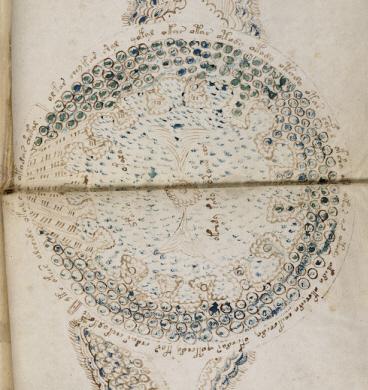 |
| f86v, Right rosette. MS 408. Credit: Beinecke Rare Book and Manuscript Library, Yale University. |
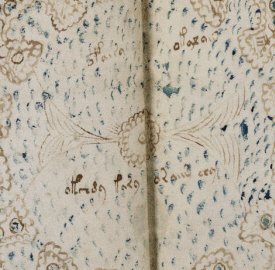 |
u59
|
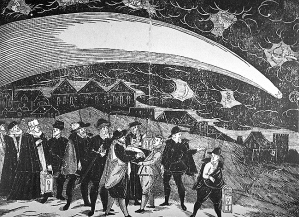 |
||
|
|
The Great Comet of 1577, woodcut by Jiri Daschitzsky. Public Domain image. Source: Wikimedia Commons |
LEFT ROSETTE
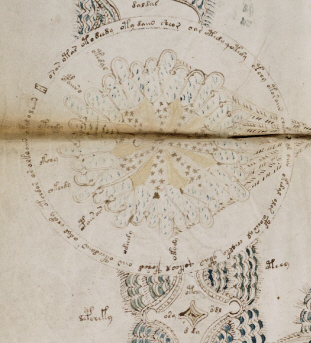 |
|
|
Rosette content undetermined.
BOTTOM ROSETTE
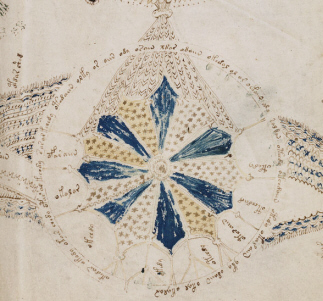 |
|
|
The central part of
this rosette resembles the layout of the nymphs in the zodiac folios, mostly the
nymphs lie within rings but Gemini, Scorpio and Sagittarius have a few outside
the rings to the top. Gemini has the most similar layout and 5 nymphs outside
the rings to the top (Scorpio and Sagittarius have 3 each), in the zodiac
discussion I suggested the Gemini folio depicted a total solar eclipse and the
top, outer ring the cycle of Mercury. Tycho observed partial solar eclipses and
total lunar eclipses from Ven and discussed the total solar eclipses of 1560 and
1567 (the eclipse of 1560 he observed as a partial eclipse from Copenhagen and
that of 1567 from Rostock). The layout of the centre of the bottom rosette may
depict the subject matter of eclipses, it may however just be a coincidental
likeness. It may refer to the same month as the Gemini folio which appears to
indicate June and which I have suggested is actually May but as the eclipses Tycho saw occurred in April and August would suggest that if it indicates the
month of the Gemini folio then the subject matter is not eclipses.
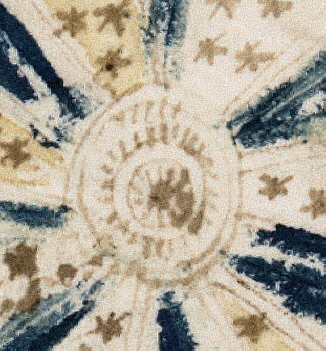 |
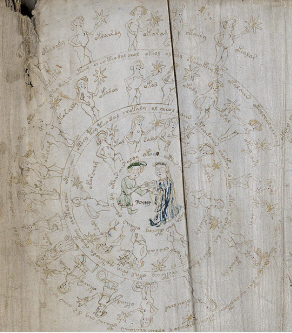 |
| f86v, cropped. MS 408. Credit: Beinecke Rare Book and Manuscript Library, Yale University. Overlay by P. Han showing markers | f71v. Gemini? MS 408. Credit: Beinecke Rare Book and Manuscript Library, Yale University. Overlay by P. Han showing markers |
TOP ROSETTE
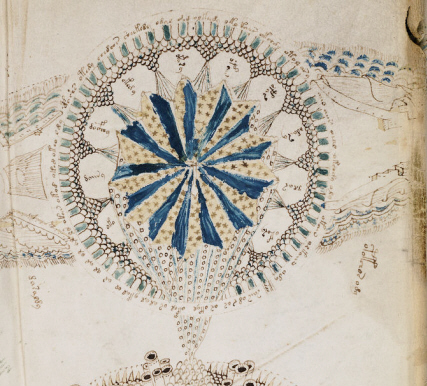 |
|
|
Rosette content unknown, but the presence of 13 spokes in
the rosette suggests it may be about the motion of the Moon with its 13 lunar
cycle year. Given its position next to what I suggest is the paper mill on Ven
it could even represent the water wheel for the mill.
What appear to be buildings on cliffs in the link to the top right rosette may
be a representation of the paper mill Tycho built on Ven, apart from paper
production the processing of hides for leather production and the milling of
flour was also carried out there as separate functions but all powered by the
same water mill fed from the numerous artificial ponds created on Ven. He also
built a printing press.
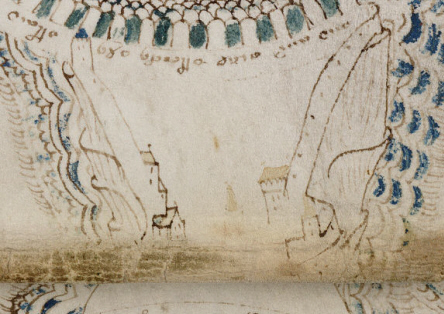 |
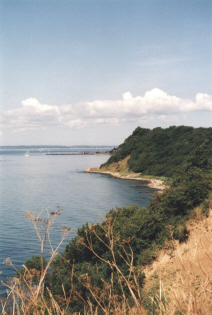 |
|
| f86v, join between top and top right rosette, possibly showing the paper mill on Ven and Backenfalls. MS 408. Credit: Beinecke Rare Book and Manuscript Library, Yale University. |
|
These are links to images of the paper mill circa 1580 and its location down a steep bank. These steep cliffs down to the sea are a particular feature of the island of Ven and are known as "backafalls" (hill falls) and may explain a lot of the cliff-like imagery on the rosettes folio:
http://www.hven.net/MBACKEN/M%F6llan1d.GIF
http://www.hven.net/MBACKEN/mbpan1a5.GIF
An example of “Backafalls”.
http://members.virtualtourist.com/m/p/m/30af55/
THE MARKERS
The markers on this folio are the moist complex of all the folios with each of the 9 rosettes having at least 1 marker. When I first the markers for this folio I was struck by its familiar look which was very much like a navigation chart, but given the suggested topic I have treated it like chart but of the sky rather than land or sea. I suggest it shows in detail the position in the sky of SN 1572 using mostly the same stars Tycho used to position it. There appears to be another or extended star chart also which I explore as a chart of stars marking the zenith and stars marking SN 1054. I do not go into detail on the background of this concept but rather explore it just in relation to the rosette markers, however a useful paper can be found here on the subject:
http://adsabs.harvard.edu/full/1977QJRAS..18..340S
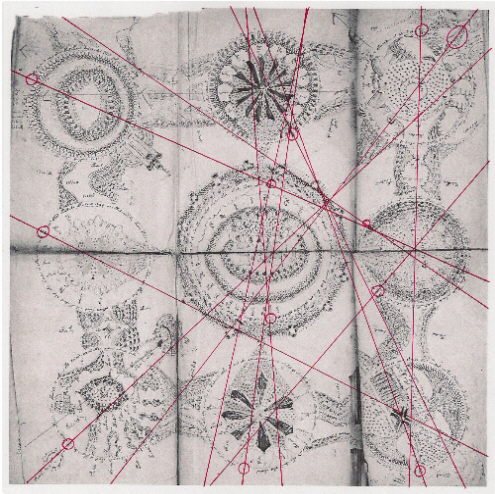 |
|
|
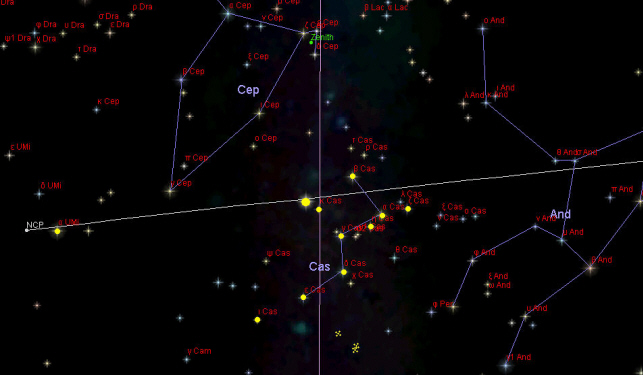 |
|
|
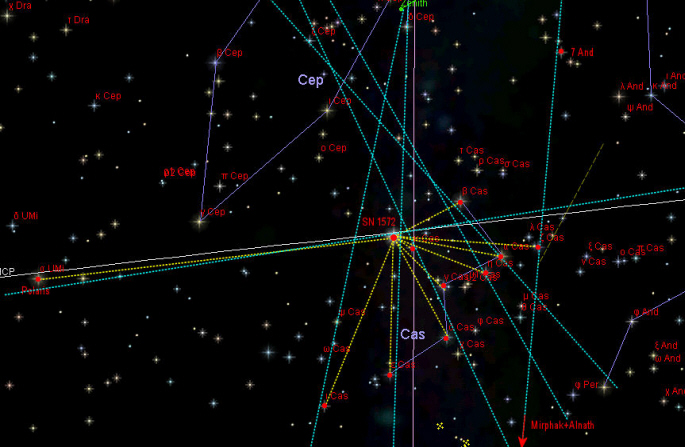 |
|
|
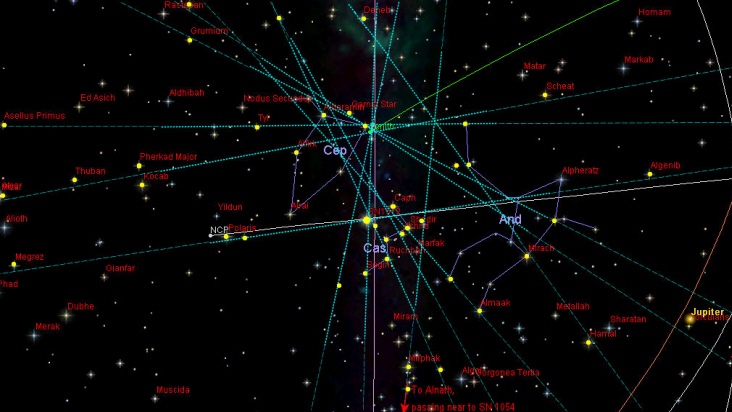 |
|
|
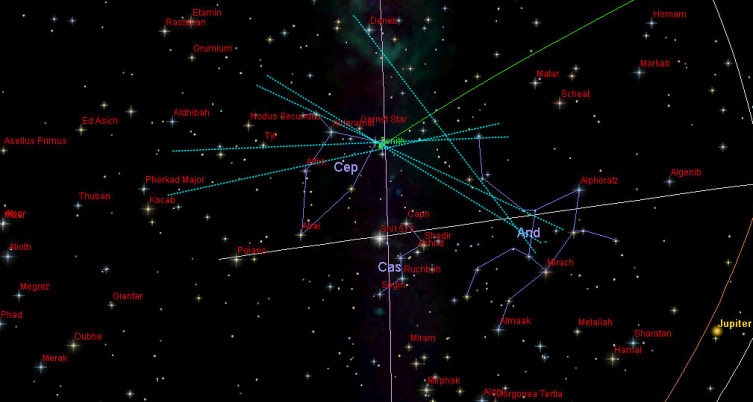 |
|
|
Below is a composite image of the rosettes and the star map lined up with the markers. There is some distortion involved in rotating the star map image but it gives an overall picture of where this thory would place stars within the rosette folio, Cassiopea and Cepheus and the zenith are the focal points with the vertical line on the right locating Deneb to Mirach and Hamel. Rotating the image to give SN 1572 directly below the zenith what has now become the vertical line on the right points down near to SN 1054. Cardinal directions are shown in both images.
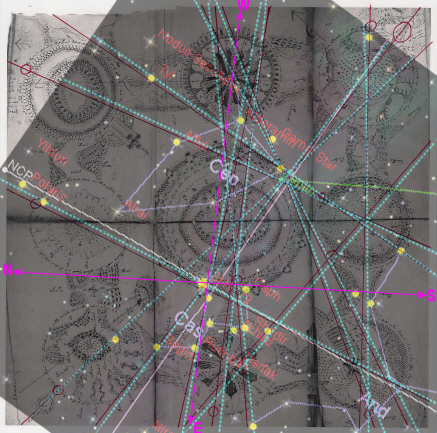 |
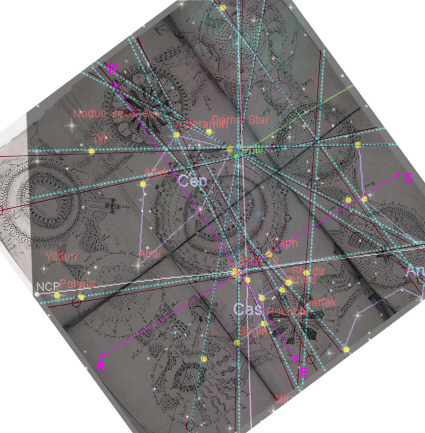 |
||
|
|
OTHER ROSETTES
The subject matter of the rosettes top, bottom, right and left are very difficult to determine but as they appear to radiate out of the central rosette they may be details of observations made from Uraniborg. While Tycho was on Ven he observed comets (including the great comet of 1577), total lunar and partial solar eclipses, compiled many observations on the motions of the planet Mars and the Moon, compiled a catalogue of stars among other things.
*****A paper regarding the location of SN 1572:
Stephenson, F. R. & Clark, D. H. "The Location of the Supernova of AD 1572." Quarterly Journal of the Royal Astronomical Society, Vol. 18, p.340-350. SAO/NASA Astrophysics Data System (ADS).
http://adsabs.harvard.edu/full/1977QJRAS..18..340S
Richard Santa-Coloma's beautiful rendering of the rosette folio in 3-D brings it to life in a unique way:
http://www.youtube.com/watch?v=NGrNIB0sHYk
Copyright © 2010 P. Han